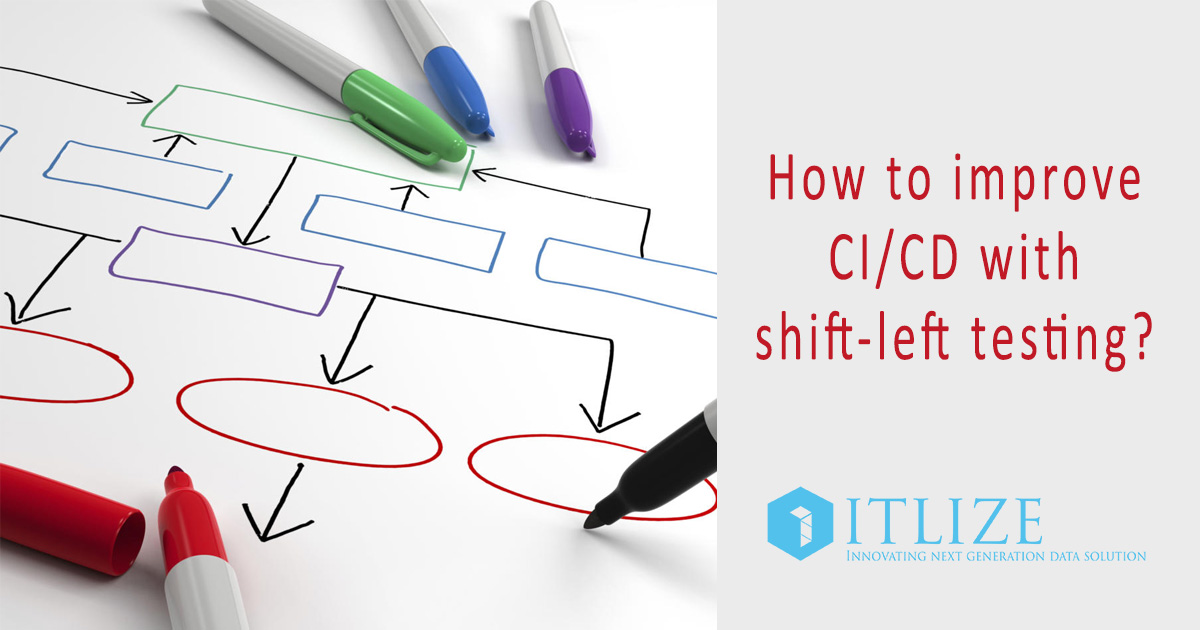How to improve CI/CD with shift-left testing?

Deep learning and machine learning specialist, well-versed with experience in Cloud infrastructure, Block-chain technologies and Big Data solutions.
January 31, 2020
DevOps Services
DevOps enables various organizations and firms to deliver applications and services at high velocity. This ensures the firms to evolve and improve their products at a faster pace than other firms. The latest technology in DevOps is adept in combining software development with IT operations. The collaboration aids in reducing the launch time of various products and services by the organizations or firms. Automation process, inculcated by DevOps helps teams to do work at a faster pace than the traditional ways.
DevOps consists of Continuous Integration (CI), Continuous Development, and Continuous Deployment. CI is adept in dealing with all kinds of tests after the full development of an application (app). CD aids in knowing the weak-links and helps release the software developments securely. Continuous deployment helps in the effective distribution of app updates and relevant software releases. With these three, the whole process gets automated in a way it should be.
For improving the DevOps services, business organizations or firms must work on CI, CD, and Continuous deployment. A way to do this is by improving CI/CD with shift-left testing.
Testing processes in DevOps (CI/CD)
It is essential to properly test the software before they are released into the market. Traditionally, the testing process takes a lot of time. This used to affect the whole design process as well. DevOps continuous integration practices with unit testing frameworks and automated testing have resulted in a fast evolution process. Many testing practices are quality tested during coding, integration, and deployment. The process has enabled saving a lot of time while designing and developing web or mobile applications.
CI/CD pipelines aid in running the quality tests during code integration and delivery phases. Designers and developers get alert about software issues such as code breaks. So, they can immediately work on rectifying those.
Continuous Testing Process
A procedure of early testing throughout the whole development lifecycle. The continuous testing process helps an organization to accelerate the whole quality assessment process. This enables to achieve the quality customers expect from an organization’s product design team. The testing process enables constant feedback that helps developers to fix various bugs, which might crop up at any stage of production. Automation is not required for the continuous testing process. It helps the whole process run much faster and hence, it’s highly recommended.
Shift-Left Testing
This type of testing comes very early in the product design and development process. For instance, if bugs are found after the whole development process it would have to be re-done; this will be a big waste of time and resources.
The idea behind shift-left testing is to bring all the quality control processes to the left side of the developmental model. Testing processes done at the very beginning of the design phase helps build an appropriate testing strategy. In this scenario, testing keeps happening throughout every stage. The process aids in spotting issues right at the beginning, which can be rectified then and there itself. A good way to avoid issues and save a considerable amount of time in product design and development process.

Benefits and facts about Shift-Left Testing
An early detection feature enables this testing process to find any bugs or issues early in the production and rectify them, as aforementioned. Shift-left testing can save a lot of time as well as money. The testing process is highly reliable and is a part of the continuous testing process. There forms a bond between developers and testers, through healthy interactions during the whole product development process. Product is delivered within a short period as the testing & development go hand-in-hand.
Effective planning is essential to incorporate shift-left testing into the product development process. The project managers should be properly trained and prepared before the incorporation of this testing process. Enables in maintaining effective quality levels during the phases of training and transition. Developers should be made aware of the advantages of testing and this aids n adding testability to their skillset. Silos in the business organization can be reduced with swift feedbacks and fixing of problems faster and efficiently. The new testing procedure is implemented by making sure the organization is participating in regular code audits.
Shift-Left Testing: A part of the continuous testing process
• Employs the same testing process as that of the continuous one.
• Continuous testing aids in conducting tests for DevOps pipeline and shift-left testing defines the objectives needed for these processes.
• Continuous testing incorporates the whole of planning, designing, developing, and deploying of the processes and shift-left testing takes place before starting each phase or stage.
• Shift-left testing strengthens continuous testing against unexpected bugs and issues.
• Through the language of BDD, testers get the luxury to know things beforehand and do not have to wait for developers to update them.
• Tests can be run and re-run until the required quality is assured.
How does a project work look like when testing and developing goes hand-in-hand? (Shift-left testing!)
A testing process in a conventional way eats up a lot of time. For instance, during the earlier days, people used to wait on various requirements to be done for the testing process to commence. These requirements might be new builds, features, or models. Also, the development processes should be done fast so that a testing team can take over and check everything. Shit-left testing helps increase the pace of both developing as well as testing processes.
An integrated team member will observe both testing as well as the developing process. So, these integrated team members get to learn all the nuances of product development from design, creation, testing, and production. The whole data is grouped under one pool for the ease of developing and testing.
With the help of an API (Application Programming Interface), a tester can technically learn more about the project, which will be useful for fixing any bugs or issues as per the product development requirements. This can simplify the whole production and product development process.
Having an experienced tea to test the developmental process aids in the developers to become more assured and clear about the segments under the testing and designing process. An integrated testing team should know about how to work with API tools, how to process and mold the available data and how to work with codes (even at a basic level). Otherwise, the testing process will get stuck at square one.
Developers and testers can improve their craft
Knowledge and information inspire people to imagine and develop weird ideas that might work out extremely well for their projects. Usually, managers gauge tester performances by the number of bugs and the number of tests run in a day. These help developers to improvise and innovate.
How to begin with shift-left testing?
A small team can be selected and a group of testers (or even a single one) will work with the rest on a feature from the beginning. The team will consist of a developer, testers, product manager as well as a business analyst. Meetings will be conducted with workshops on writing codes and developing products together.
Behavior-driven development can accelerate the shift-left process. This enhances cross-team collaboration by giving a platform to interact with each other. Automation becomes a part of this testing process. Otherwise, the testing tool might encounter a lot of issues even when working with the best platforms available. For instance, TestLeft is an automated testing tool that aids in incorporating the shift-left testing process.
Interaction between the team members will help in improving the whole production as well as the developmental process.
The shift-left testing process can be easily integrated on to the Mainframe
As is observed, the shift-left testing process helps to fix code issues very easily. This is done in applications that are developed based on CI/CD. This testing process can improve the speed of applications done with CI/CD.
Mainframe applications are written using old programming languages; these are prone to errors and is susceptible to bug attacks. Shift-left testing can catch these bugs. Problems can be detected early and fixing is done without interrupting the CI/CD process.
Conclusion
The shift-left testing process, which is a part of the continuous testing process is an innovative technique that aids in effective and efficient software analysis. This aids in fixing bugs and issues as soon as they are found; because, testing, designing, and developing products in a business organization or firm goes hand-in-hand. There are automatic tools in various platforms that allow running shift-left testing of software processes as well as code fixes; a wonderful way to develop quality products in a short time.













